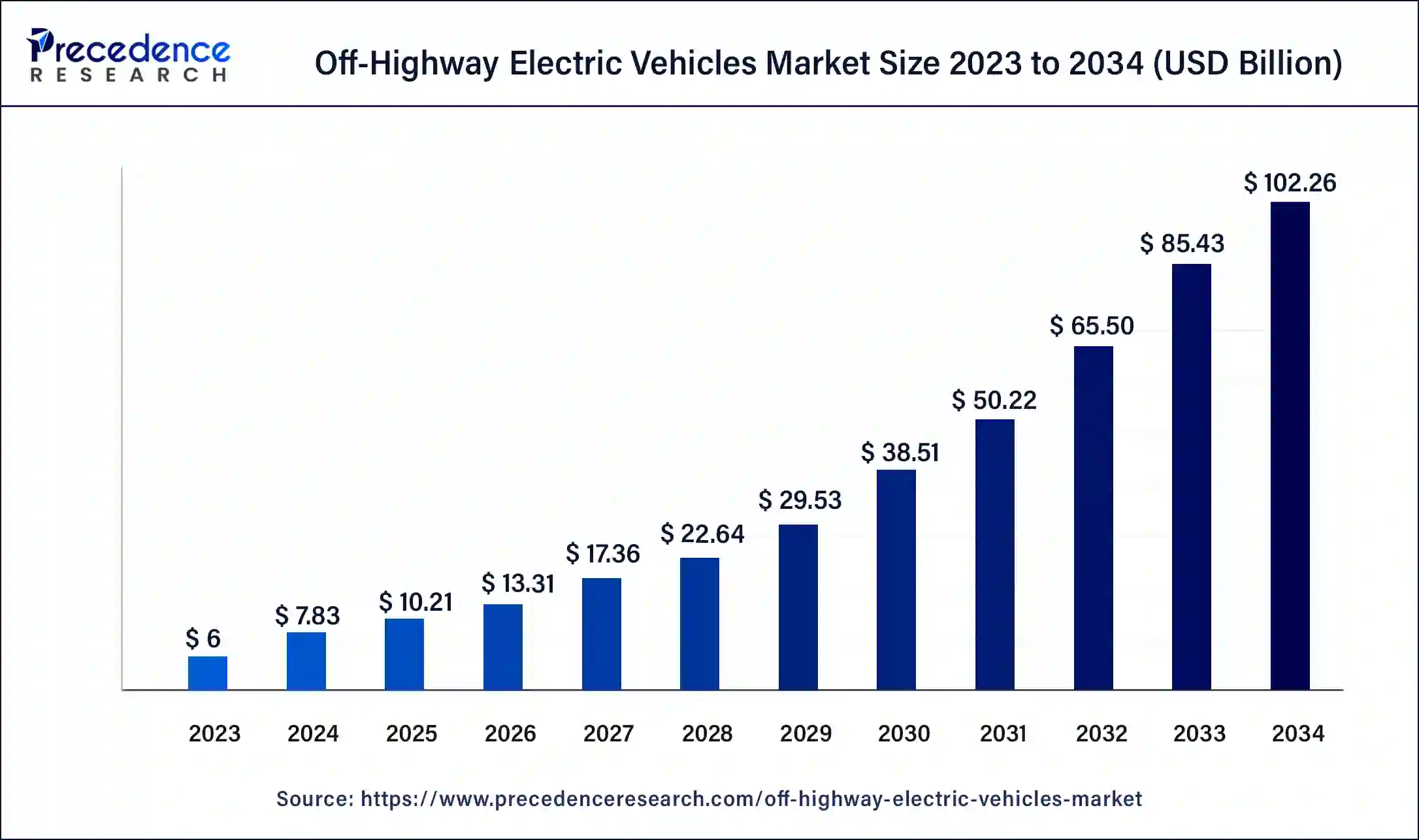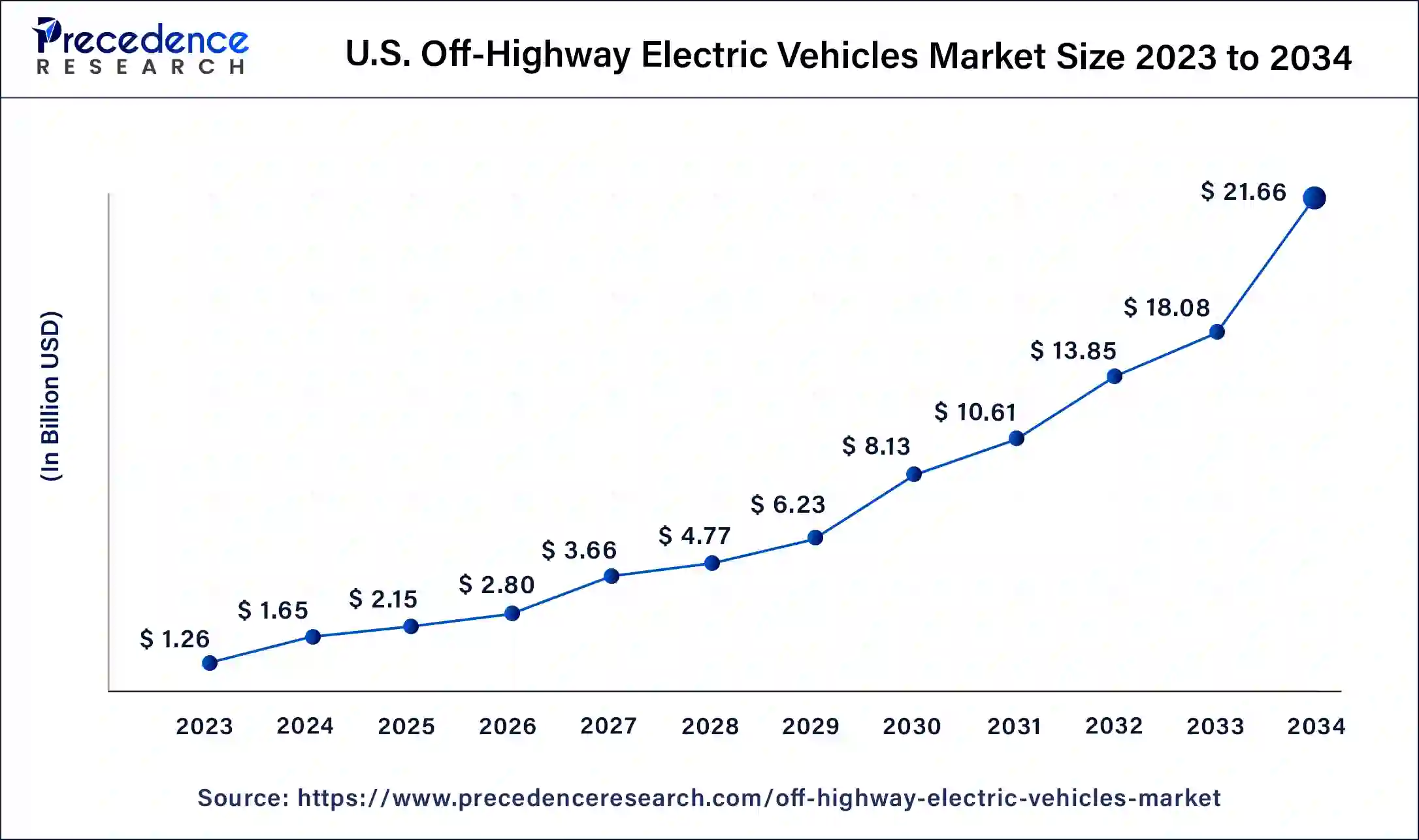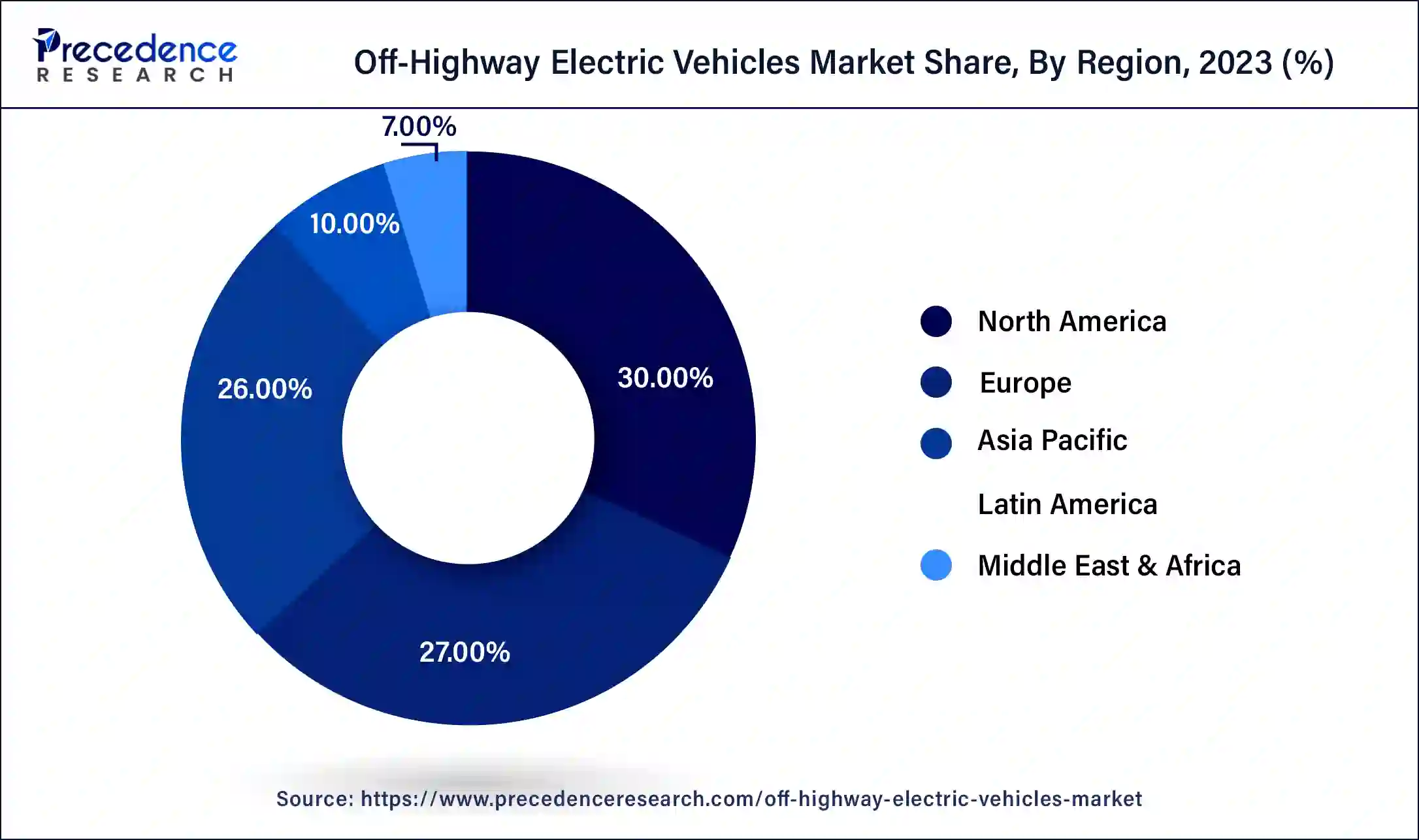January 2025
The global Off-highway electric vehicle market size was USD 6 billion in 2023, estimated at USD 7.83 billion in 2024 and is anticipated to reach around USD 102.26 billion by 2034, expanding at a CAGR of 29% from 2024 to 2034.
The global Off-highway electric vehicle market size accounted for USD 7.83 billion in 2024 and is anticipated to reach around USD 102.26 billion by 2034, expanding at a CAGR of 29% from 2024 to 2034.

The global Off-highway electric vehicle market size was valued at USD 6 billion in 2023 and is expected to be worth around USD 102.26 billion by 2034, at a CAGR of 29% from 2024 to 2034.

North America showed prominent growth in the global Off-highway electric vehicle market accounting for a significant market share in 2023. Due to the presence of key companies such as Caterpillar, Deere & Company, and CNH Industrial N.V., the area holds a dominant share in the forecast era. In the North American region, the construction industry is increasing, affecting the region's demand for off-highway electric equipment. According to the United States Environment Protection Agency (EPA), the U.S. adopted rigorous emission requirements in 2018; off-highway equipment accounted for almost 30 percent of overall emissions of greenhouse gases. The increased emissions of greenhouse gases have pushed companies to introduce new electric models for off-highway vehicles. In the Asia Pacific region, the off-highway EV market is projected to grow from 2024 to 2034 at the highest CAGR of 34.4 percent. Asia Pacific countries, such as China and India, reported a strong performance in 2023 due to the increase in investment in infrastructure. Due to the existence of numerous OEMs, low production prices, low labor costs, and the availability of excellent facilities, China is one of the major contributors to the production of construction machinery.

The growing growth of infrastructure in developing markets and the introduction of redevelopment projects in developed countries are boosting sales of electric highway vehicles. Strict emission standards by government agencies, such as emission standards for greenhouse gas ( GHG ) emissions by the U.S. The Environmental Protection Agency ( EPA) and the European Commission are both main factors influencing the global market for off-road electric vehicles ( EVs). In addition, the market for off-highway electric vehicles is also leveraged by factors such as improved electrical machinery performance, lower noise and vibration levels, lower overhaul costs, and others.
Government authorities have introduced increasing stringency in emission standards for off-highway vehicles, such as emission standards for greenhouse gas (GHG) emissions by the U.S. India, and China VI Environmental Protection Agency (EPA), BS-VI. The increasing strictness of emission standards has shifted the attention of OEMs toward alternative powertrain sources such as hybrid electric and full electric off-highway vehicles that exploit global demand. Electrification of heavy-duty off-highway vehicles is on the rise, and businesses are highly interested in exploring how this emerging development will complement their current business models. There are many advantages to the electrical system of heavy-duty vehicles. However, in conducting research and implementing the electrical solution, factors such as battery technology, infrastructure, and overall cost of production play a vital role.
| Report Highlights | Details |
| Market Size in 2023 | USD 6 Billion |
| Market Size in 2024 | USD 7.83 Billion |
| Market Size by 2034 | USD 102.26 Billion |
| Growth Rate from 2023 to 2034 | CAGR of 29% |
| Largest Market | North America |
| Base Year | 2023 |
| Forecast Period | 2024 to 2034 |
| Segments Covered | Electric Vehicle, Application, Region |
| Regions Covered | North America, Europe, Asia-Pacific, Latin America, and Middle East & Africa |
The construction segment accounted for the highest share of around 38.2% in 2023, The segment includes electric construction equipment, such as electric loaders, electric excavators, and more. One of the key factors driving the market demand for this equipment has been growing investments by governments worldwide to build public infrastructure. In order to comply with the tougher emission requirements, OEMs are introducing electric off-highway equipment. In the future, legislation could mandate zero emissions on heavy-duty construction equipment to pave the way for OEMs to drop diesel-powered engine output and go all-electric.
The agriculture off-highway electric vehicle segment is expected to grow at a CAGR of 22.1% from 2024-2034. The segment covers electric agricultural equipment such as electric tractors, electric harvesters, etc. Consumers have begun embracing new farm machinery and advanced agricultural processes to achieve higher yields in regions such as North America and Europe. Thus, the demand for electric and hybrid tractors and other farm equipment is expected to rise in the forecasted timeline.
The HEV segment accounted for the biggest revenue share of 66.2% and is predicted to retain its dominance over the forecast period. These vehicle types are intended to increase the use of the internal combustion engine in combination with the electric powertrain. The stringent emission regulations by different government agencies such as the European Commission and the United States The demand for hybrid off-highway propulsion equipment from the EPA is rising and pushing manufacturers to build more environmentally friendly off-highway vehicles. A hybrid engine, a variation of the diesel-electric propulsion system, has been adopted by off-highway vehicle manufacturers since 2017.
The BEV Off-highway electric vehicle segment is likely to expand at the maximum CAGR of 29.5% over the forecast period. Growth can be likely to downturn in the adoption of internal combustion engine vehicles and CO2 aim restrictions. The power needed for the majority of off-highway vehicles to operate is, however, too high; the use of fully electric BEVs is therefore still limited. The reduction in lithium-ion battery prices and advancements in battery technology would leverage the demand for BEVs in the forecast period.
The global Off-highway Electric Vehicle market seeks intense competition among the market players owing to rapidly changing consumer preferences. Further, the industry participants are prominently adopting inorganic as well as organic growth strategies that include partnership, collaboration, merger & acquisition, and many others to maintain their competitive edge in the global market. Apart from this, they invest prominently in R&D activity for new product development & advancements.
Segments Covered in the Report
This research study comprises a complete assessment of the market by means of far-reaching qualitative and quantitative perceptions, and predictions regarding the market. This report delivers a classification of the marketplace into impending and niche sectors. Further, this research study calculates the market size and its development drift at global, regional, and country from 2020 to 2032. This report contains a market breakdown and its revenue estimation by classifying it on the basis of material, application, and region:
By Application
By Electric Vehicle
By Regional
For inquiries regarding discounts, bulk purchases, or customization requests, please contact us at sales@precedenceresearch.com
No cookie-cutter, only authentic analysis – take the 1st step to become a Precedence Research client
January 2025
January 2025
January 2025
September 2024